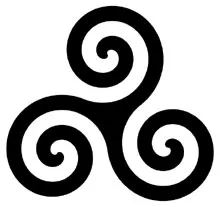
This sign can be found all over the world. The three overlapping spirals and the three human legs spiraling out symmetrically from a common center are the most common incarnations that exist across numerous cultures and generations. The three number sevens, or any figure made up of three-pronged protrusions, are similar formations. It is most frequently acknowledged as a Celtic sign portraying the Mother Goddess and the three phases of womanhood: maiden – innocent and pure, mother – loving and nurturing, and crone – elderly, experienced, and wise.
